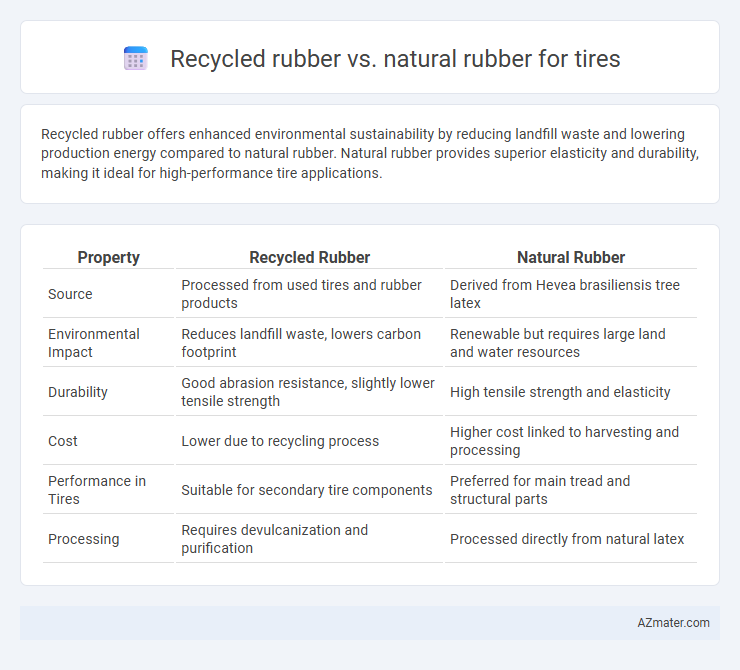Recycled rubber offers enhanced environmental sustainability by reducing landfill waste and lowering production energy compared to natural rubber. Natural rubber provides superior elasticity and durability, making it ideal for high-performance tire applications.
Table of Comparison
| Property | Recycled Rubber | Natural Rubber |
|---|---|---|
| Source | Processed from used tires and rubber products | Derived from Hevea brasiliensis tree latex |
| Environmental Impact | Reduces landfill waste, lowers carbon footprint | Renewable but requires large land and water resources |
| Durability | Good abrasion resistance, slightly lower tensile strength | High tensile strength and elasticity |
| Cost | Lower due to recycling process | Higher cost linked to harvesting and processing |
| Performance in Tires | Suitable for secondary tire components | Preferred for main tread and structural parts |
| Processing | Requires devulcanization and purification | Processed directly from natural latex |
Introduction to Rubber Types Used in Tires
Recycled rubber and natural rubber differ significantly in tire manufacturing, impacting performance and sustainability. Natural rubber, derived from Hevea brasiliensis trees, offers superior elasticity and resilience, essential for high-quality tire tread. Recycled rubber, sourced from processed scrap tires, enhances cost-efficiency and environmental benefits but may exhibit reduced durability compared to natural rubber.
Overview of Natural Rubber
Natural rubber, derived from the latex of Hevea brasiliensis trees, offers exceptional elasticity, tensile strength, and resilience, making it a preferred material for high-performance tires. Its biodegradability and renewability highlight environmental advantages, but susceptibility to heat, oxygen, and ozone aging limits durability compared to synthetic or recycled alternatives. The global natural rubber market continues to expand due to demand in automotive and industrial sectors, emphasizing sustainable harvesting practices to balance supply and ecological impact.
What is Recycled Rubber?
Recycled rubber is produced by processing used tires or scrap rubber materials into granules, powders, or molded products, offering an eco-friendly alternative to virgin materials. This sustainable material retains durability and flexibility, making it suitable for tire manufacturing while reducing landfill waste and conserving natural resources. Compared to natural rubber, recycled rubber incorporates post-consumer or post-industrial waste, enhancing environmental benefits without significantly compromising tire performance.
Environmental Impact: Recycled vs. Natural Rubber
Recycled rubber significantly reduces landfill waste and lowers greenhouse gas emissions compared to natural rubber, which requires extensive land use and water resources for cultivation. The extraction of natural rubber contributes to deforestation and biodiversity loss, while recycled rubber supports circular economy principles by repurposing end-of-life tires. Using recycled rubber in tire production minimizes environmental degradation and promotes sustainable resource management.
Performance Comparison in Tire Applications
Recycled rubber in tire applications offers enhanced environmental benefits but typically exhibits lower elasticity and reduced abrasion resistance compared to natural rubber, affecting overall tire performance. Natural rubber provides superior tensile strength, better resilience under high temperatures, and improved grip, which are critical for safety and durability in tires. Advances in blending technologies aim to optimize performance by combining recycled rubber's sustainability with natural rubber's mechanical properties.
Cost Analysis: Recycled vs. Natural Rubber Tires
Recycled rubber tires typically cost 20-40% less than natural rubber tires due to lower raw material expenses and reduced processing energy. Natural rubber tires offer superior durability and performance, which can justify their higher price, often 15-30% more than recycled alternatives. Lifecycle cost analysis shows recycled rubber tires reduce environmental impact and initial investment but may result in higher replacement frequency compared to premium natural rubber tires.
Durability and Longevity Factors
Recycled rubber in tires offers enhanced environmental benefits but may exhibit reduced durability compared to natural rubber due to potential impurities and altered polymer chains. Natural rubber provides superior tensile strength, elasticity, and abrasion resistance, resulting in longer tire lifespan and better performance under stress. Longevity factors favor natural rubber tires especially in high-load and high-temperature conditions, where their molecular structure maintains integrity more effectively over time.
Challenges in Using Recycled Rubber for Tires
Recycled rubber faces challenges in tire manufacturing due to inconsistent material quality and contamination, which can compromise tire performance and safety. The vulcanization process is less effective with recycled rubber, resulting in weaker elasticity and durability compared to natural rubber. Regulatory restrictions and limited recycling technologies further hinder the widespread adoption of recycled rubber in tire production.
Innovations in Tire Manufacturing with Rubber
Innovations in tire manufacturing leverage recycled rubber to enhance sustainability without compromising performance, utilizing advanced devulcanization techniques that restore rubber's elasticity and durability. Natural rubber remains essential for its superior tensile strength and resilience, especially in high-performance and off-road tires, where flexibility and grip are critical. Hybrid tire compounds combining recycled and natural rubber optimize wear resistance, reduce environmental impact, and maintain safety standards in modern vehicle tires.
Future Trends: The Role of Rubber Sustainability in Tires
Recycled rubber is gaining traction in the tire industry as manufacturers prioritize sustainability and environmental impact reduction, with innovations improving its durability and performance to rival natural rubber. Natural rubber remains essential for its superior elasticity and grip, but supply chain concerns and deforestation pressures drive exploration of alternative sources and enhanced recycling techniques. Future trends highlight integrating eco-friendly materials and advanced recycling technologies to create tires that balance sustainability, performance, and cost-effectiveness.

Infographic: Recycled rubber vs Natural rubber for Tire
 azmater.com
azmater.com